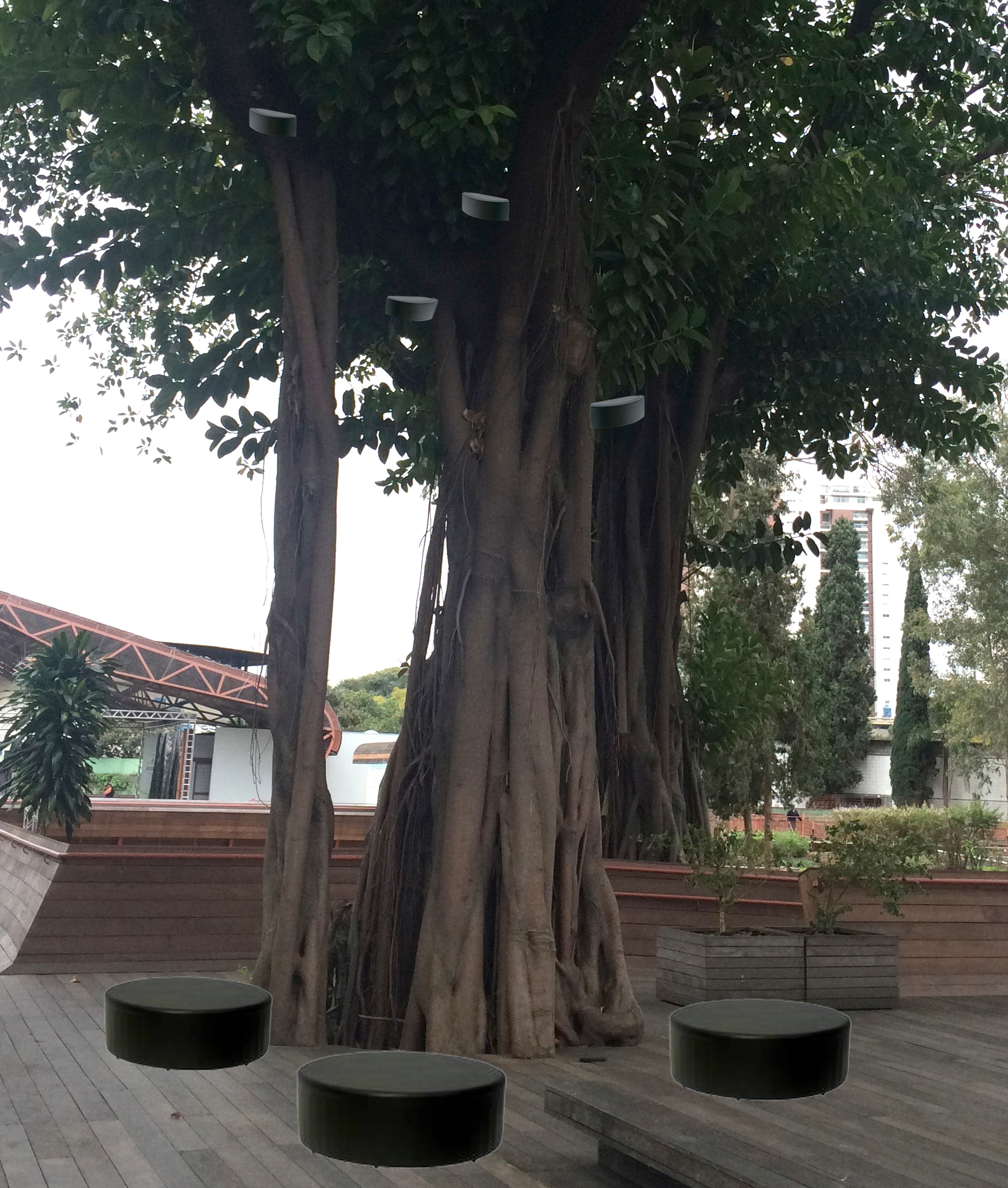Sistemas Ecos 2014
Praça Victor Civita, São Paulo, SP
Lost Sounds
Imagined as a sort of ecology of sounds and noises, Lost Sounds presents the result of extensive research on local history. The work’s objective is to recreate soundscapes on the everyday experience of the incinerator and the movement surrounding it. Lost Sounds offers the public an experience in sound, but it is up to the spectator to observe the space and build his or her own images. The sounds represent the remains of what has been incinerated, of buried ashes, seeking to reconstruct the memory of what took place there.
Old trees represent the real connection with the contaminated soil and its past. One of them has six speakers hung on its branches, as not only does the tree touch the contaminated ground, it also grows and lives upon it. Sounds of animals, noises of fire, sounds of bodies, of walking and of various different movements make up a sort of ecology of sounds. For the production of Lost Sounds, a sound system was programmed so that six speakers with independent stereo audio channels would reproduce 388 sounds, grouped into eight different subjects.
The work reveals a sound history that rebuilds the past of an old incinerator in São Paulo, Latin America’s largest metropolis, with everything that took place there, with the human and mechanical movements in its surroundings."Lost Sounds" was made to rebuild human memories, and is an important way of understanding the potency of touching the public through the senses. With the purpose of recreating the everyday soundscapes of the incinerator and bringing this experience to the audience through sound memories, "Lost Sounds" gives people the possibility to build their own images.
With the purpose of recreating the soundscapes of the incinerator and revealing to the audience the sounds that represent the remains of what was cremated there, the ashes buried, the work seeks to reconstruct the memory of what happened.
Sons Perdidos
Pensado como uma ecologia de sons e ruídos apresenta o resultado de uma pesquisa sobre a história local. Tem o objetivo de recriar passagens sonoras sobre o “dia a dia” do incinerador e a movimentação no seu entorno. Lost sounds traz ao público uma experiência sonora sobre o passado, a oportunidade de ativar a memória através dos sons e reconstruir em sua própria imaginação uma possível história local. Os sons representam os restos do que foi incinerado, das cinzas enterradas, buscando reconstruir a memória do que se passou.
As árvores antigas são a conexão real com o subsolo contaminado e seu passado, por isto, o site specific Lost sounds foi pensado para o local. Seis caixas de som são penduradas em uma antiga árvore, pois esta, não só toca o solo contaminado, mas cresce e vive sobre ele. Ruídos de fogo, sons do corpo, do caminhar e de movimentos diversos são organizados para montar uma ecologia de sons. Nesta experiência, cabe ao espectador construir suas próprias imagens.Para a realização de Lost Sounds, um sistema de som foi programado para que seis caixas de som, associadas a canais de áudio estéreo independentes, reproduzissem os 388 sons preparados para o trabalho.
Os grupos sonoros são: 21 sons internos do corpo; 24 sons de movimentos humanos; 17 sons de aparelhos hospitalares; 9 sons de urgência; 12 sons de engrenagens; 13 ruídos com referência de animais; 53 ruídos de demolição; 36 ruídos de fogo e fornalhas e 203 tipos de sons sobre o caminhar humano, os passos.
Sons circulam de caixa à caixa de diversas maneiras, enquanto ruídos de engrenagens, de demolições e sons humanos vão randomicamente se reorganizando. Uma paisagem sonora é criada para ir se redesenhando continuamente. Lost sounds é o resultado de uma pesquisa realizada para o projeto Sistemas Ecos 2014.
Lost Sounds
Imagined as a sort of ecology of sounds and noises, Lost Sounds presents the result of extensive research on local history. The work’s objective is to recreate soundscapes on the everyday experience of the incinerator and the movement surrounding it. Lost Sounds offers the public an experience in sound, but it is up to the spectator to observe the space and build his or her own images. The sounds represent the remains of what has been incinerated, of buried ashes, seeking to reconstruct the memory of what took place there.
Old trees represent the real connection with the contaminated soil and its past. One of them has six speakers hung on its branches, as not only does the tree touch the contaminated ground, it also grows and lives upon it. Sounds of animals, noises of fire, sounds of bodies, of walking and of various different movements make up a sort of ecology of sounds. For the production of Lost Sounds, a sound system was programmed so that six speakers with independent stereo audio channels would reproduce 388 sounds, grouped into eight different subjects.
The work reveals a sound history that rebuilds the past of an old incinerator in São Paulo, Latin America’s largest metropolis, with everything that took place there, with the human and mechanical movements in its surroundings."Lost Sounds" was made to rebuild human memories, and is an important way of understanding the potency of touching the public through the senses. With the purpose of recreating the everyday soundscapes of the incinerator and bringing this experience to the audience through sound memories, "Lost Sounds" gives people the possibility to build their own images.
With the purpose of recreating the soundscapes of the incinerator and revealing to the audience the sounds that represent the remains of what was cremated there, the ashes buried, the work seeks to reconstruct the memory of what happened.




